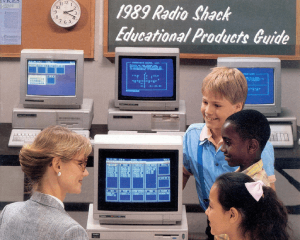1989
 | |
| 1989 | |
| Products and events | See 1989 categories |
1989 was a year of continued expansion of the use of computers in multiple industries.
Computers
Systems
Apple released several Macintosh computers, including the Macintosh Portable, Macintosh IIcx and Macintosh IIcl.
Atari Corporation released models of Atari ST known as the Atari 520 STE and Atari 1040 STE.
Commodore International released the Commodore PC40-III, a desktop computer that was IBM PC compatible.
Dell Computer Corporation established on-site service programs due to few local third-party service centers.
IBM released four models of Personal System/55 computers in Japan. The IBM 5550-V was a 25 MHz i386DX desktop, the 5570-V was a 25 MHz i386DX tower, the 5530-T was a 20 MHz i386DX desktop with an integrated display, and the 5530Z SX was a 20 MHz i386DX desktop which also had an integrated display.
NeXT made a test release of its NeXT Computer to universities in the United States at a base price of $6,500 USD.
Components
Intel released the 32-bit i486 microprocessor. It was available in speeds ranging from 20 MHz to 50 MHz.
Motorola released the MC68302, a microcontroller which used a CPU core based on the 68000.
Operating systems
Apple released version 6.0.4 of Mac OS with the release of the Macintosh Portable and Macintosh IIci.
Atari Corporation released versions 1.04 and 1.06 of TOS, the operating system for AtariST computers.
Commodore International released version 1.3.2 of the Amiga operating system.
Digital Research released versions 3.40 and 3.41 of DR DOS, the MS-DOS compatible operating system.
IBM released OS/2 1.2, which supported the High Performance File System, which was created to overcome the limitations of the File Allocation Table file system.
NeXT released version 0.9 beta of NeXTSTEP, included in the NeXT computers released in test markets at the United States university campuses.
Software
Microsoft released Windows 2.11, the final version of its second graphical operating environment for DOS.
Internet
Tim Berners-Lee launched a network of hypertext documents from his NeXT computer at CERN, creating the prototype of the World Wide Web.
Video games
Game Boy
Nintendo released the 8-bit monochrome portable video game console, Game Boy, in Japan and North America.
Games released include Alleyway, Baseball, Battleship, Castlevania: The Adventure, Sokoban, Mickey Mouse, Fist of the North Star: 10 Big Brawls for the King of Universe, Golf, Hyper Lode Runner, Malibu Beach Volleyball Seaside Volley, Master Karateka, Motocross Maniacs, Pachinko Time, Puzzle Boy, QBillion, Revenge of the 'Gator, Shanghai, Shogi, Super Mario Land, The Sword of Hope, Teke! Teke! Asmik-kun World, Tennis, Tetris, and Warrior in the Tower of the Spirit World SaGa, and Yakuman.
Nintendo Entertainment System
Samsung released the 8-bit Nintendo Entertainment System in South Korea under the Comboy brand name.
PlayChoice-10
Nintendo released several games for its timer-limited NES-based 8-bit PlayChoice-10 arcade hardware, including Baseball Stars by SNK, Ninja Gaiden and Tecmo Bowl by Tecmo, and Teenage Mutant Ninja Turtles by Konami.
Sega Mega Drive
Sega released the 8-bit Sega Genesis in North America.
Sega Master System
Samsung released the 8-bit Sega Master System in South Korea as the Gam*Boy.
TurboGrafx-16
NEC released the 16-bit TurboGrafx-16 in North America, France, and the United Kingdom.
Motion pictures
Animation
Pixar released the four-minute long computer-animated short film Knick Knack.
The Walt Disney Company released The Little Mermaid, which included a final battle which was colored using the Computer Animation Production System developed by Pixar.
Live action
Twentieth Century Fox produced The Abyss, a feature film that featured the first use of photorealistic fluid morphing in the scene where the water creature mimics the faces of the human characters.
Companies and organizations founded
APE, the company that created the Earthbound series, was founded in Kyoto, Japan.
Capcom was founded by Kenzo Tsujimoto after he was forced out of Irem, a company he founded in 1974.
Enix, the company that created the Dragon Quest series, was founded in Japan.
LK Avalon, an adventure game developer, was founded in Poland.
Nintendo Research & Development 4, the team at Nintendo managed by Shigeru Miyamoto, was renamed Nintendo Entertainment Analysis & Development.
Revolution Software, an adventure game developer, was founded in York, England.
Companies and organizations closed
Eldridge Park Arcade, an arcade active since 1923 and one of the longest continually running arcades, closed in Elmira, NY.
Infocom, the interactive fiction developer, was closed by its parent company Activision.